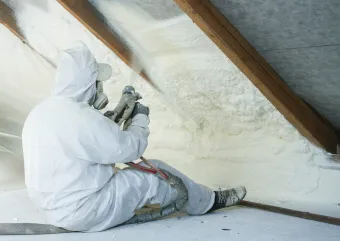If you’re considering electrification, there are many steps you can take to prepare your home before you even consider the electric technology you want to install. One of the best early steps we recommend before electrification is weatherization. Get more details on the ins and outs of weatherization in this article.
Weatherization Activities
In the energy space, a building’s envelope is the barrier around it that separates indoor and outdoor spaces. Weatherization seals this envelope. This reduces or eliminates opportunities to pass between the two, which can cause your home to be hotter or cooler than intended. Typically, weatherization refers to insulation and air sealing, but it can include window upgrades. This may not seem like an electrification project at first, but it will help make your electric systems work more efficiently in the future.
An estimated 60% of Minneapolis houses have little to no insulation in the walls or attic, a number that increases in older homes. When your home is poorly weatherized, air that’s been heated or cooled may escape outside, while outside air may come inside. This means your home’s heating and cooling system has to work overtime to keep your indoor air at the set temperature, which raises costs. By weatherizing, you can address these concerns, saving money and feeling more comfortable at home in the process.
Insulation and Air Sealing
Insulation reduces the transfer of heat from one space to another, leading to warmer spaces in the winter and cooler spaces in the summer. Insulation projects are usually paired with air sealing projects, which help seal small gaps and cracks in your home that can leak air. When done properly, insulation and air sealing can save you up to $900 a year on heating and cooling costs while making your home noticeably more comfortable. Read more about wall insulation here and attic insulation and air sealing here.
Windows
We hear from many residents who are concerned about drafts around their windows. In our experience, windows are not usually the main source of heat loss or drafts in a home. Replacing them can be expensive, making them a lower-priority project for many. We recommend starting with insulation and air sealing, then seeing if you’re still experiencing discomfort. If you’re looking for a cost-effective solution to drafty windows, you can make sure every window has at least two panes of glass. If you have single-pane windows, installing storm windows over them can create a double-pane window at a lower cost.
Post-Weatherization Ventilation
When you properly weatherize your home, it’s important to make sure your home is still getting a healthy amount of fresh air through ventilation. Having fresh air at home will maintain a healthy indoor environment by reducing the amount of moisture and pollutants that build up inside. Depending on your home and the weatherization upgrades you make, you may not need mechanical ventilation. If you do need it, you have options.
Exhaust-Only Systems
Exhaust-only systems use fans that run continuously to remove stale air from the home. These fans replace existing bathroom fans or kitchen vent hoods, then run at a low speed all the time, with an option to increase the speed as needed. Fresh air is then intentionally brought back into the home for a safe and comfortable environment.
Balanced Systems
Balanced systems use special equipment to exhaust stale air and pull in fresh air from outside. These are typically connected to the duct system. Heat recovery ventilators (HRVs) can recover heat energy from the exhausted air. Energy recovery ventilators (ERVs) also recover heat energy, and can transfer humidity between incoming and outgoing air, which can help balance indoor humidity levels. Both include filtration for incoming air. Balanced systems can be expensive to install and are not strictly necessary for most homes.
Financial Incentives for Weatherization
Financial incentives for weatherization vary based on your location, but many utility rebates, City rebate matches, and federal tax credits may be available to you. Please visit our incentives page for more detailed information on how to bring down the upfront costs of your weatherization projects.
First You Weatherize, Then You Electrify
When you electrify your home, not every step will be installing electric technology. By taking extra time to invest in your home’s weatherization, you’ll set the stage for future upgrades to perform better, now and in the future. Even if a full electrification overhaul isn’t in the cards for you right now, weatherization upgrades can make a meaningful impact on your home’s energy use, your energy bills, and your comfort around the house. For more information on the weatherization projects that may be right for you, we recommend getting a home energy audit.
